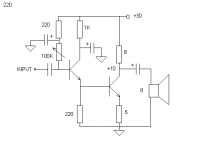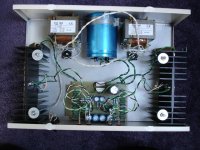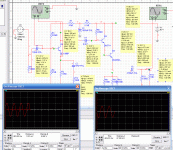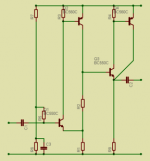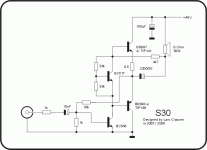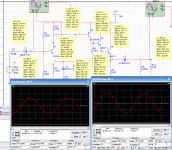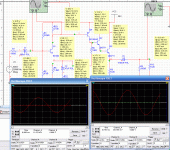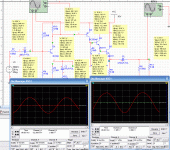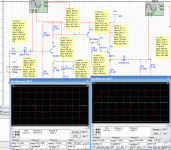Great!
Another free Nelson Pass amplifier.
Difficult to build?
I wouldnt think so
Another free Nelson Pass amplifier.
Difficult to build?
I wouldnt think so

Nelson Pass said:I do like a challenge.
Select both devices for high beta. I assumed 50
on the power device, and 100 on the driver.
Attachments
ar-3 variant
Boxed in:
here is the latest version of the prototype of the simplest amplifier. It still is built around the AR-3 circuit. The real headphone amp is smaller in physical size, I have no picture at hand, but will post it as soon as I have that available.
Boxed in:
here is the latest version of the prototype of the simplest amplifier. It still is built around the AR-3 circuit. The real headphone amp is smaller in physical size, I have no picture at hand, but will post it as soon as I have that available.
Attachments
hi rudy,
I do not see 2n3055. Did you use any other transistor?. Do you now what is the latest equivalent of BC109 and 2n3055?.
i Can't find them. Let me know.
How much the output wattage ? 1 W?. And also what is your powupply rating ? 30 v 1A?
And also how many 2n3055 we can add second stage? WIll the sound quality go bad if we addd more transistors in second stage?.
Let me know.
Thanks
Alexk
I do not see 2n3055. Did you use any other transistor?. Do you now what is the latest equivalent of BC109 and 2n3055?.
i Can't find them. Let me know.
How much the output wattage ? 1 W?. And also what is your powupply rating ? 30 v 1A?
And also how many 2n3055 we can add second stage? WIll the sound quality go bad if we addd more transistors in second stage?.
Let me know.
Thanks
Alexk
3055
I use 2n3055 and it is fitted on the heatsinks on both sides of the chassis. I use around 25V and 1 Amps. The (power) resistor belonging to the output 3055 has been changed to 6,8 Ohms (25 Watts, also fitted on the heat sinks). The driver transistor was in the original AR3 (if I remember correctly) also a 3055 but can be changed to any other same type smaller power transistor (BD type for example). No transistor in this circuit is critical, you can try anything as long as the power rating of the 'end' transistor is big enough and can stand 1 Amp easily. Sorry not to be more precise but I don't have the complete history of building this thing at hand, in the mean time somebody else is playing with it. Output power is around a meagre 1 Watt at 8 Ohms, but enough for a lot of listening.
I use 2n3055 and it is fitted on the heatsinks on both sides of the chassis. I use around 25V and 1 Amps. The (power) resistor belonging to the output 3055 has been changed to 6,8 Ohms (25 Watts, also fitted on the heat sinks). The driver transistor was in the original AR3 (if I remember correctly) also a 3055 but can be changed to any other same type smaller power transistor (BD type for example). No transistor in this circuit is critical, you can try anything as long as the power rating of the 'end' transistor is big enough and can stand 1 Amp easily. Sorry not to be more precise but I don't have the complete history of building this thing at hand, in the mean time somebody else is playing with it. Output power is around a meagre 1 Watt at 8 Ohms, but enough for a lot of listening.
DID you make any new class A amplifier only with BJT ?
As far as Transistor replacing 2n3055 are 2n3772,2n5886 and MJ21294G. Hope i can improve the output power. Which one is power resistor in this circuit ?. 3 parallel 330 Ohm? SHould i change that to another value?.
Let me know
Thanks
Alexk
As far as Transistor replacing 2n3055 are 2n3772,2n5886 and MJ21294G. Hope i can improve the output power. Which one is power resistor in this circuit ?. 3 parallel 330 Ohm? SHould i change that to another value?.
Let me know
Thanks
Alexk
bjt amp
I did try several variants of the amps in this same cabinet at the time of the beginning of the discussion on this topic. If you want more power with the basis set-up of the AR-3 using 8 Ohms speakers you have to change the 330/330/330 resistors to one big resistor of 6,8 Ohms (or 8,2 Ohms). At the time no circuit could give more than around 1 watts using the same minimum amount of components and the given design criteria, which the reason why I gave up at the time. The new circuit of last week looks promising, I am very curious about the specifications and listening test from builders...
I did try several variants of the amps in this same cabinet at the time of the beginning of the discussion on this topic. If you want more power with the basis set-up of the AR-3 using 8 Ohms speakers you have to change the 330/330/330 resistors to one big resistor of 6,8 Ohms (or 8,2 Ohms). At the time no circuit could give more than around 1 watts using the same minimum amount of components and the given design criteria, which the reason why I gave up at the time. The new circuit of last week looks promising, I am very curious about the specifications and listening test from builders...
boxedin said:hi,
what is last week circuit ? which thread?.
Thanks
Alexk
This is my pricinpal suggestion for a simple and good amplifier.
Works in Class A.
The gain in the voltage amp stage, Q1+Q2, is set by (R2/R1) + 1
Output, voltage across R8 at Q3 emitter should be half supply voltage.
R8 should be same as impedance of load, or smaller.
For better efficiency ( more power output )
R8 should be replaced by a constant current source.
With higher currents and power transistors this makes a good Class A headphone amplifier / low power amp.
With only small signal transistors and lower currents
it makes a good preamplifier.
Attachments
boxedin said:Here is the picture of the my simulation.
I get only 11 mA Ac signal (Peak to peak) going through 8 ohms.
But DC current through 330 ohm resistors is 500 MA dc current. Ca we convert this to AC current somehow?.
Let me know.
Thanks
Alexk.
boxedin
have you done some simulations using my
last circuit of the week ?
I think you be surprised how well it will do !

Hi Guys
I have found this thread intriguing. How many times have we heard the trivial phrase: The best solution is often the simplest one. However amplifier construction is clearly an area where this phrase does NOT rule...
Many of the proposed circuits suffer from very low efficiency, very poor performance, very low power, and very poor stability. All sacrificed on the alter of simplification or one might say: oversimplification.
So i want to throw in my 50c, for the simplest BJT amplifier, i can think of, that is not completely useless as a practical amplifier.
It's not very special or unconventional, but it will give a decent 30W of power with good efficiency, and proper performance and stability. (But nothing more). Already i feel like throwing in a differential stage, a thermo stabilization, input resistor for DC plop limiting etc. This would better the performance, and stability remarkably, but on the other hand these are not strictly necessary, and will get me further away from the 'simplest solution'. Anyway like i said, i really don't think the simplest solution is always the best. Take a look
I have found this thread intriguing. How many times have we heard the trivial phrase: The best solution is often the simplest one. However amplifier construction is clearly an area where this phrase does NOT rule...
Many of the proposed circuits suffer from very low efficiency, very poor performance, very low power, and very poor stability. All sacrificed on the alter of simplification or one might say: oversimplification.
So i want to throw in my 50c, for the simplest BJT amplifier, i can think of, that is not completely useless as a practical amplifier.
It's not very special or unconventional, but it will give a decent 30W of power with good efficiency, and proper performance and stability. (But nothing more). Already i feel like throwing in a differential stage, a thermo stabilization, input resistor for DC plop limiting etc. This would better the performance, and stability remarkably, but on the other hand these are not strictly necessary, and will get me further away from the 'simplest solution'. Anyway like i said, i really don't think the simplest solution is always the best. Take a look
Attachments
I really think we all should combine all our brains and make one single ended simple class A amp with different feature set.
How do you say your circuit works ? based on what ?
How did you test it ? or is it just a theory?.
What is the input signal voltage range?.
How much output current goes through 8 Ohms.
Did you test with 1 HZ to 300 Khz input range ?
Let me know.
Thanks
Alexk
toronto
Note: I am Noob here. I have no clue about designing amplifier. I just do copy and paste. Thats all. Hahahaha. I am here to learn something new.
How do you say your circuit works ? based on what ?
How did you test it ? or is it just a theory?.
What is the input signal voltage range?.
How much output current goes through 8 Ohms.
Did you test with 1 HZ to 300 Khz input range ?
Let me know.
Thanks
Alexk
toronto
Note: I am Noob here. I have no clue about designing amplifier. I just do copy and paste. Thats all. Hahahaha. I am here to learn something new.
Ok i just modified the rudistor circuit little. Add some modification by adding a PNP Transistor in between.
Here is my simulation output at different frequencies and different Mv input sinewave.
50mv 20 Hz
50Mv20000Hz
500Mv 20Hz
500mv20000Hz
Your input welcome. I do not want to add any more capacitors. But i can replace one value with another. Do not want to add any more transistors.
if you have any input or if you can copy and simulate in your own software and give me feedback. That will be awsome.
I do not use any calculation to design amplifier. I just did copy and paste. So don't blame me. Hahaha.
Thanks for your patience.
Alexk
Toronto
Here is my simulation output at different frequencies and different Mv input sinewave.
50mv 20 Hz
50Mv20000Hz
500Mv 20Hz
500mv20000Hz
Your input welcome. I do not want to add any more capacitors. But i can replace one value with another. Do not want to add any more transistors.
if you have any input or if you can copy and simulate in your own software and give me feedback. That will be awsome.
I do not use any calculation to design amplifier. I just did copy and paste. So don't blame me. Hahaha.
Thanks for your patience.
Alexk
Toronto
Attachments
500mv20000Hz
Simulation works, i have to make this simple Class A amp. If anyone have some tips...let me know.
I have to make +45 V 10 A powersupply to keep sufficient power so it does n't clip. I may also have to see what protection i can add.
Thanks
Alexk
Simulation works, i have to make this simple Class A amp. If anyone have some tips...let me know.
I have to make +45 V 10 A powersupply to keep sufficient power so it does n't clip. I may also have to see what protection i can add.
Thanks
Alexk
Attachments
S30
Hello Lars,
that's an interesting circuit. I agree with your remarks, it's all about the balance between simplicity and quality or usefulness. In the end you have a two-stage amplifier and that's quite something for 30 Watt output power (using BJT's that is, with mosfets we of course have the Pass designs which do the same thing).
In fact that makes me think that the real task is to design Pass amps, in the same spirit and with the same straightness of design and philosophy, but now with BJT's. For some reason Pass himself does not see that as an challenge because he prefers fet's for their greater linearity. On the other hand there is a school that prefers BJT's to fets (for instance Rod Elliott if I remember correctley, that's why he called one of his designs DOZ, death of zen).
I also built some Pass designs and they are very good indeed. But then again, just for fun I recently (this week...) built the classic A51 amp from Sugden late 60's, using modern components (2n3055 isn't exactly a modern component, but the impression still applies with this old goodies in it!) and a good power supply: and damn, this thing appeals in some way more than do the Aleph designs, it just sounds more natural, more flowing, more ... maybe more like good tubes maybe. But I don't want to do the discussion all over again, just let's make some simple BJT designs and let everybody try and have fun and listen.
Why do you put the speaker to the + volage rail?
Some specifications would be nice: input sensitivity, idle current, output power at 8 and 4 Ohms etc.
Hello Lars,
that's an interesting circuit. I agree with your remarks, it's all about the balance between simplicity and quality or usefulness. In the end you have a two-stage amplifier and that's quite something for 30 Watt output power (using BJT's that is, with mosfets we of course have the Pass designs which do the same thing).
In fact that makes me think that the real task is to design Pass amps, in the same spirit and with the same straightness of design and philosophy, but now with BJT's. For some reason Pass himself does not see that as an challenge because he prefers fet's for their greater linearity. On the other hand there is a school that prefers BJT's to fets (for instance Rod Elliott if I remember correctley, that's why he called one of his designs DOZ, death of zen).
I also built some Pass designs and they are very good indeed. But then again, just for fun I recently (this week...) built the classic A51 amp from Sugden late 60's, using modern components (2n3055 isn't exactly a modern component, but the impression still applies with this old goodies in it!) and a good power supply: and damn, this thing appeals in some way more than do the Aleph designs, it just sounds more natural, more flowing, more ... maybe more like good tubes maybe. But I don't want to do the discussion all over again, just let's make some simple BJT designs and let everybody try and have fun and listen.
Why do you put the speaker to the + volage rail?
Some specifications would be nice: input sensitivity, idle current, output power at 8 and 4 Ohms etc.
- Status
- This old topic is closed. If you want to reopen this topic, contact a moderator using the "Report Post" button.
- Home
- Amplifiers
- Solid State
- simplest amplifier possible with BJT's?
